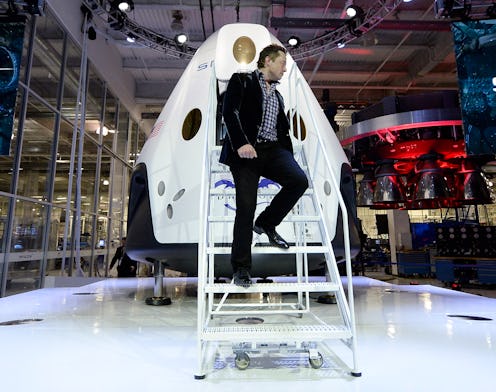News
Elon Musk's Brand-New Spacecraft
Elon Musk, the real life version of Tony Stark, has just unveiled a new spacecraft that looks like it might have come out of an Ironman movie. On Thursday, the inventor and CEO of SpaceX unveiled his company's newest creation: Elon Musk's Dragon V2 space vessel, which Musk claims will "revolutionize access to space." The Dragon V2's chief purpose is to serve as the coolest ferry on (and off) the planet, shuttling astronauts to and from the International Space Station.
This makes our morning commute look even lamer by comparison. The V2 is actually an improvement on an earlier version of the Dragon, launched in 2012. This spaceship was meant for food and supplies, not people, and the cargo carrier has made four successful trips to and from space in the last two years.
The Dragon V2 has key policy implications, as the United States has been entirely dependent on Russian Soyuz rockets for space transport since NASA's shuttle fleet was shut down in 2011. Given recently growing tensions between the U.S. and Russia, particularly over the Ukraine crisis and Vladimir Putin's annexation of Crimea, American space travel has been jeopardized. Deputy Prime Minister Dmitry Rogozin, threatening an eye for an eye response to American sanctions, suggested that the U.S. "deliver its astronauts to the ISS with the help of a trampoline." As such, it seems wise to decrease American reliance on Russian technologies.
Moreover, using the Soyuz rockets has been extraordinarily expensive for space travel, as seats run a cool $71 million per person for a roundtrip ticket. As such, NASA has pitted three leading companies against one another to attempt to build the best and most efficient "space taxi" by 2017. Musk and SpaceX are in competition with Boeing and the Sierra Nevada Corp., but neither company has produced a working vessel yet. SpaceX, on the other hand, has now released two.
The Dragon V2 is able to hold up to seven passengers, and is revolutionary in its landing precision and in its reusability. Whereas previous rockets combust upon reentering Earth's atmosphere, and are subsequently rendered unusable, SpaceX's newest creation will face no such problem.
Instead, Musk said, "You can just reload, propel it and fly again." This is thanks to an improvement in heat shields that will better protect the spacecraft from high temperatures upon leaving and returning to Earth. If this is true, the Dragon V2 would be extremely cost effective, as it would eliminate the need to constantly throw away and reproduce spacecrafts.
The design of the shuttle is also particularly interesting — the cone shaped craft with landing legs that allow it to stand upright somewhat resembles an alien ship. But its design is carefully concocted, with a "sleek" interior and a combination of technology and manual overrides designed for emergency purposes. But most impressive of all is its new engine, known as SuperDraco thruster engines.
These engines are installed as a safety precaution, and would allow the manned capsule to be separated from the rocket in case of an emergency. Because the SuperDraco is built into the walls of the Dragon V2, it would not detach from the craft immediately after launching, as most thruster escape engines do. Another first for the engines would be in its construction, as Musk plans to use 3D printers to create the thrusters, a first for spacecraft.
The Dragon V2's unveiling was strategically timed to immediately follow a Russia Soyuz space mission, which sent three new astronauts to the ISS on Wednesday. Musk, who seems to want not only astronauts to travel to space, but the everyman as well, has said that he will build the Dragon V2 with or without NASA funding. Tests will begin as early as 2015, and it seems that everyone will be vying for a seat on the experiment.
